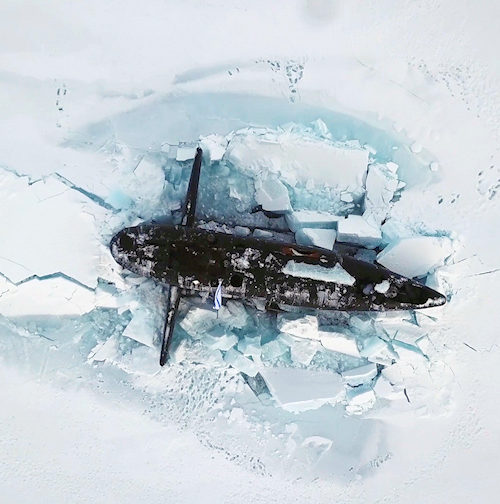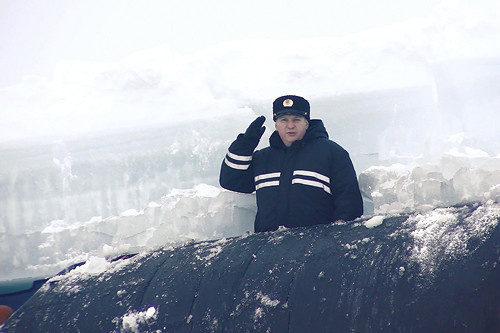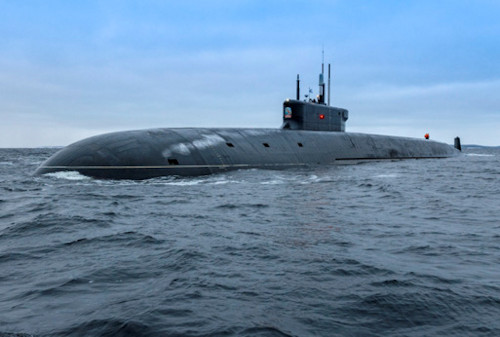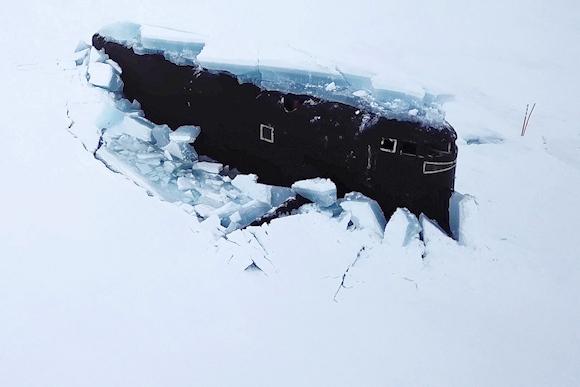In March 2021, three nuclear submarines simultaneously emerged near the Alexandra Island of the Franz Joseph archipelago. The first boat was a class SSBN Delta IV (Project 667BDRM), The second was the special operations submarine BS-64 Podmoskovye, while the third boat was the Knyaz Vladimir (K-549), the last entered service of the class Borei (Project 955A). According to Russian MoD sources, two of the three submarines carried a total of 32 ballistic missiles between RSM 56 Bulava (Borei) and RSM 25 Sineva (Delta IV). These missiles can carry up to ten Multiple independently targetable reentry vehicles (MIRV) with a minimum of six tested the Bulava and of four warheads the Sineva. According to the Independent Military Review in the course of the tutorial Umka the three submarines carried a total of 192 nuclear warheads.
It was not since 1996 that Russian nuclear submarines resurfaced from the ice of the Arctic, when the Severstal (TK-20) class Typhoon emerged and launched a couple of RSM-52 missiles Sturgeon.
The commander of the Russian Navy (VM-F), Admiral Nikolai Yevmenov, said the Arctic mission included 43 events and involved over 600 military and civilian units and nearly 200 weapon systems and vehicles. The exercise continued in adverse weather conditions with an average temperature of minus 30 ° C, ice over 1,5 meters thick and wind of 32 m / sec.
 Admiral Yevmenov argued that the event was unprecedented for the Navy.
Admiral Yevmenov argued that the event was unprecedented for the Navy.
Navigating under the ice is a very dangerous element for submariners, as the ice sometimes reaches the bottom of the sea. In addition to the emergence of three SSBNs within a range of 300 meters, a pair of MiG-31 fighters flew over the North Pole and also refueled in flight. A submarine launched an exercise torpedo under the canopy and was subsequently recovered and pulled out of the ice.
In the same scenario, the 200th Arctic Motorized Rifle Brigade also conducted a tactical simulation during adverse weather events and in unknown terrain away from the main base, also using dog and reindeer sleds.
The weapons and instruments employed confirmed the tactical and technical characteristics of resistance to high latitudes and low temperatures. The Defense Ministry said it will soon test various aircraft assets in the Arctic, including Su-34 and Su-35 fighters and B-200 amphibians. The latter is often used to fight fires, but its primary mission in the Arctic will be to conduct rescue operations.
The Russian government, also based on the results of the exercise, will shortly present to President Vladimir Putin a unified document on Arctic development, intended to combine economic and military aspects of the country's projection of power in the northern region. The document, ordered by Putin in early March, is expected to provide an agenda of Russia's military and economic plans as the country prepares to chair the Arctic Council in 2021-2023. The body, established in 1996, includes members from Canada, Denmark, Finland, Iceland, Norway, Russia, Sweden and the United States.
According to a March report by the Stockholm International Peace Research Institute (SIPRI), 80% of Russia's natural gas and 17% of its oil production comes from the Arctic.

The region as a whole is seen by observers as a future battleground for both military and economic competition between rival powers.
“This region has traditionally been and remains in the sphere of our special interests. Virtually all aspects of national security are concentrated here: military-political, economic, technological, environmental and resource "Putin said in 2014 during the Russian Security Council meeting on the Arctic region.
In the same year that Russia annexed the Crimean peninsula from Ukraine, the Russian military doctrine was also enacted which for the first time included a sentence about "protection of Russian interests in the Arctic".
Submarines Delta IV (Project 667BDRM) are third generation SSBNs and will remain the backbone of Russian maritime nuclear deterrence until fourth generation SSBNs Borei (Project 955) with Bulava missiles will not all come in line. These boats joined the Navy in the 80s and there are currently five in service, all with the Northern Fleet (K-51 Verkhoturye, K-114 Tula, K-117 Bryansk, K-18 Karelia, K-407 Novomoskovsk).
I Delta IV have been updated since 2005, with the replacement of electronic equipment, radars, the propeller-rudder system and the installation of new ballistic missiles Sineva.

The sixth Delta IV class boat, the K-64 Podmoskovye, was transformed between 1999 and 2002 into BS-64 for special operations by replacing the old one KS-411 obtained from a class boat Yankee. To the Podmoskovye the silos for SLBM missiles have been removed, replacing them with scientific and experimental laboratories as well as being able to transport a boat Project 10831 Losharik.
the class Borei (Project 955) is armed with 16 missiles Bulava, the Russian Navy currently has three boats in service Project 955: K-535 Yuri Dolgoruky in the Northern Fleet, the K-550 Alexander Nevsky and K-551 Vladimir Monomakh in the Pacific Fleet. The K-549 Knyaz Vladimir (photo) under the Northern Fleet is the first Project 955A of the Voyenno-Morskoy Flot.
At the Sevmash shipyards in Severodvinsk are being built on Knyaz Oleg, Generalissimus Suvorov, which should be delivered by 2021, theImperator Aleksandr III and Knyaz Pozharsky all belonging to Project 955A.
By the current year, the last two scheduled boats of the class, the Dmitry Donskoy and Knyaz Potyomkin.

Photo: MoD Fed. Russian












